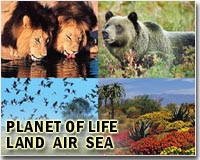| . |  |
. |
Chicago IL (SPX) Feb 09, 2010 New research suggests that animals living at high latitudes grow better than their counterparts closer to the equator because higher-latitude vegetation is more nutritious. The study, published in the February issue of The American Naturalist, presents a novel explanation for Bergmann's Rule, the observation that animals tend to be bigger at higher latitudes. Ever since Christian Bergmann made his observation about latitude and size in 1847, scientists have been trying to explain it. The traditional explanation is that body temperature is the driving force. Because larger animals have less surface area compared to overall body mass, they don't lose heat as readily as smaller animals. That would give big animals an advantage at high latitudes where temperatures are generally colder. But biologist Chuan-Kai Ho from Texas A and M University wondered if there might be another explanation. Might plants at higher latitudes be more nutritious, enabling the animals that eat those plants to grow bigger? To answer that question, Ho along with colleagues Steven Pennings from the University of Houston and Thomas Carefoot from the University of British Columbia, devised a series of lab experiments. They raised several groups of juvenile planthoppers on a diet of cordgrass, which was collected from high to low latitudes. Ho and his team then measured the body sizes of the planthopppers when they reached maturity. They found that the planthoppers that fed the high-latitude grass grew larger than those fed low latitude grass. The researchers performed similar experiments using two other plant-eating species-grasshoppers and sea snails. "All three species grew better when fed plants from high versus low latitudes," Ho said. "These results showed part of the explanation for Bergmann's rule could be that plants from high latitudes are better food than plants from low latitudes." Although this explanation applies only to herbivores, Ho explained that predators might also grow larger as a consequence of eating larger herbivores. "We don't think that this is the only explanation for Bergmann's rule," Ho added. "But we do think that studies of Bergmann's rule should consider ecological interactions in addition to mechanisms based on physiological responses to temperature." It's not known why the higher-latitude plants might be more nutritious. But research in Pennings's lab at the University of Houston offers a clue. Pennings has shown that plants at low latitudes suffer more damage from herbivores than those at higher latitudes. Ho and Pennings suggest that perhaps lower nutrition and increased chemical defenses are a response to higher pressure from herbivores. Chuan-Kai Ho, Steven C. Pennings, and Thomas H. Carefoot, "Is Diet Quality an Overlooked Mechanism for Bergmann's Rule?" The American Naturalist 175:2 (Feb 2010).
Share This Article With Planet Earth
Related Links University of Chicago Press Journals Darwin Today At TerraDaily.com
 Fewer than 50 wild tigers left in China: conservation group
Fewer than 50 wild tigers left in China: conservation groupBeijing (AFP) Feb 8, 2010 Fewer than 50 wild tigers remain in China, a conservation group said Monday, voicing hope that the Year of the Tiger would not be the last for the endangered cats. Xie Yan, director of the China programme for the US-based Wildlife Conservation Society (WCS), said that just 20 years ago tigers still roamed across large swathes of China. But based on data from the year 2000, there are onl ... read more |
|
| The content herein, unless otherwise known to be public domain, are Copyright 1995-2010 - SpaceDaily. AFP and UPI Wire Stories are copyright Agence France-Presse and United Press International. ESA Portal Reports are copyright European Space Agency. All NASA sourced material is public domain. Additional copyrights may apply in whole or part to other bona fide parties. Advertising does not imply endorsement,agreement or approval of any opinions, statements or information provided by SpaceDaily on any Web page published or hosted by SpaceDaily. Privacy Statement |